An online project under the direction of the CAPE ANN MUSEUM
inv. 614
Dana Beach, Manchester
Salt Island, Good Harbor Beach
(with Mary Blood Mellen) 1860 Oil on canvas 15 1/8 x 23 1/4 in. (38.4 x 59.1 cm) No inscription found
|
Related Work in the Catalog
Explore catalog entries by keywords view all keywords »
Historical Materials
Below is historical information related to the Lane work above. To see complete information on a subject on the Historical Materials page, click on the subject name (in bold and underlined).
Manchester-by-the-Sea is located on Cape Ann in Essex County, Massachusetts. Incorporated in 1645, Manchester has many beaches and coves, including Manchester Harbor, and several small islands off the coast. Dubbed the Gold Coast in the nineteenth century, it became a summer destination for "rusticators", wealthy families escaping the heat of their residences in Boston, Philadelphia and New York. Among these was the famous shipbuilder and merchant Robert Bennet Forbes, who built a summer house, Masconomo, in the area known as Newport Beach in 1847. Lane painted portraits of vessels built and owned by Forbes, the "Massachusetts" and the steam bark "Antelope".
Typed transcription of photograph caption
Manchester Historical Museum, Manchester, Mass.
Also filed under: Forbes, Robert Bennet »
photograph
View of Kettle Cove and Baker's Island, as depicted by Lane in his painting "View from Kettle Cove" (inv.94)
Also filed under: Site Photographs »
map
Manchester Historical Museum
Also filed under: Forbes, Robert Bennet »
c. 1857
Manchester Historical Museum
In 1856 Robert Bennet Forbes bought nineteen acres of land for $2,800 from Israel F. Tappan in the section of the West Manchester shore known in those days as Newport. There he built Masconomo, named for the sagamore of the Agawam. In her unpublished letters to her son Robert, his wife Rose Greene Forbes wrote:
"...I think Father will put up a good sized cheap summer house, rough pillars, pine furniture etc., and very likely we shall all be there for two months next summer. He means to show people how rational people ought to live at the seaside. What nice times we shall have..."
The house was sold to Benjamin G. Boardman in 1865.
Also filed under: Forbes, Robert Bennet »
Book "Family Photographs" 1:45
Privately Printed: The Riverside Press
Collection of the Forbes House Museum.
Also filed under: Forbes, John Murray » // Forbes, Robert Bennet »
Schooners in Lane’s time were, with few exceptions, two-masted vessels carrying a fore-and-aft rig having one or two jibs, a fore staysail, gaff-rigged fore- and main sails, and often fore- and main topsails. One variant was the topsail schooner, which set a square topsail on the fore topmast. The hulls of both types were basically similar, their rigs having been chosen for sailing close to the wind. This was an advantage in the coastal trade, where entering confined ports required sailing into the wind and frequent tacking. The square topsail proved useful on longer coastwise voyages, the topsail providing a steadier motion in offshore swells, reducing wear and tear on canvas from the slatting of the fore-and-aft sails. (1)
Schooners of the types portrayed by Lane varied in size from 70 to 100 feet on deck. Their weight was never determined, and the term “tonnage” was a figure derived from a formula which assigned an approximation of hull volume for purposes of imposing duties (port taxes) on cargoes and other official levies. (2)
Crews of smaller schooners numbered three or four men. Larger schooners might carry four to six if a lengthy voyage was planned. The relative simplicity of the rig made sail handling much easier than on a square-rigged vessel. Schooner captains often owned shares in their vessels, but most schooners were majority-owned by land-based firms or by individuals who had the time and business connections to manage the tasks of acquiring and distributing the goods to be carried. (3)
Many schooners were informally “classified” by the nature of their work or the cargoes they carried, the terminology coined by their owners, agents, and crews—even sometimes by casual bystanders. In Lane’s lifetime, the following terms were commonly used for the schooner types he portrayed:
Coasting schooners: This is the most general term, applied to any merchant schooner carrying cargo from one coastal port to another along the United States coast (see Bar Island and Mt. Desert Mountains from Somes Settlement, 1850 (inv. 401), right foreground). (4)
Packet schooners: Like packet sloops, these vessels carried passengers and various higher-value goods to and from specific ports on regular schedules. They were generally better-maintained and finished than schooners carrying bulk cargoes (see The Old Fort and Ten Pound Island, Gloucester, 1850s (inv. 30), center; and Gloucester Inner Harbor, 1850 (inv. 240), stern view). (5)
Lumber schooners: Built for the most common specialized trade of Lane’s time, they were fitted with bow ports for loading lumber in their holds (see View of Southwest Harbor, Maine: Entrance to Somes Sound, 1852 (inv. 260)) and carried large deck loads as well (Stage Rocks and the Western Shore of Gloucester Outer Harbor, 1857 (inv. 8), right). Lumber schooners intended for long coastal trips were often rigged with square topsails on their fore masts (see Becalmed Off Halfway Rock, 1860 (inv. 344), left; Maverick House, 1835 (not published); and Lumber Schooner in a Gale, 1863 (inv. 552)). (6)
Schooners in other specialized trades. Some coasting schooners built for carrying varied cargoes would be used for, or converted to, special trades. This was true in the stone trade where stone schooners (like stone sloops) would be adapted for carrying stone from quarries to a coastal destination. A Lane depiction of a stone schooner is yet to be found. Marsh hay was a priority cargo for gundalows operating around salt marshes, and it is likely that some coasting schooners made a specialty of transporting this necessity for horses to urban ports which relied heavily on horses for transportation needs. Lane depicted at least two examples of hay schooners (see Gloucester Harbor, 1850s (inv. 391), left; and Coasting Schooner off Boon Island, c.1850 (inv. 564)), their decks neatly piled high with bales of hay, well secured with rope and tarpaulins.
– Erik Ronnberg
References:
1. Howard I. Chapelle, The History of American Sailing Ships (New York: W.W. Norton & Co., 1935), 258. While three-masted schooners were in use in Lane’s time, none have appeared in his surviving work; and Charles S. Morgan, “New England Coasting Schooners”, The American Neptune 23, no. 1 (DATE): 5–9, from an article which deals mostly with later and larger schooner types.
2. John Lyman, “Register Tonnage and its Measurement”, The American Neptune V, nos. 3–4 (DATE). American tonnage laws in force in Lane’s lifetime are discussed in no. 3, pp. 226–27 and no. 4, p. 322.
3. Ship Registers of the District of Gloucester, Massachusetts, 1789–1875 (Salem, MA: The Essex Institute, 1944). Vessels whose shipping or fishing voyages included visits to foreign ports were required to register with the Federal Customs agent at their home port. While the vessel’s trade or work was unrecorded, their owners and master were listed, in addition to registry dimensions and place where built. Records kept by the National Archives can be consulted for information on specific voyages and ports visited.
4. Howard I. Chapelle, The National Watercraft Collection (Washington, DC: Smithsonian Institution, 1960), 40, 42–43.
5. Ibid., 42–43, 73.
6. Ibid., 74–76.
A topsail schooner has no tops at her foremast, and is fore-and-aft rigged at her mainmast. She differs from an hermaphrodite brig in that she is not properly square-rigged at her foremast, having no top, and carrying a fore-and-aft foresail instead of a square foresail and a spencer.
Wood rails, metal rollers, chain; wood cradle. Scale: ½" = 1' (1:24)
Original diorama components made, 1892; replacements made, 1993.
Cape Ann Museum, from Gloucester Chamber of Commerce, 1925 (2014.071)
A schooner is shown hauled out on a cradle which travels over racks of rollers on a wood and metal track.
Also filed under: Burnham Brothers Marine Railway » // Marine Railways »
Glass plate negative
Collection of Erik Ronnberg
Also filed under: Lobstering »
Details about Maine's lumber trade in 1855, see pp. 250–52
Also filed under: Castine » // Lumber Industry »
The term “wherry”—variously spelled—has a long history with many hull types, some dating from the fifteenth century. (1) The version known to Lane appears to be a variant of the dory hull form and probably was developed by French and English fishermen in the Newfoundland fisheries before 1700. (2) From that time, the wherry and the dory co-evolved, their similarities the result of their construction, their differences the result of use. By the early nineteenth century, their forms reached their final states, if fragments of contemporary descriptions are any indication. (3)
By the time Lane was depicting wherries, the type (as used for fishing) resembled a larger, wider version of a dory. The extra width was due to greater bottom width (both types had flat bottoms), with a wider transom at the stern instead of the narrow, v-shaped “tombstone.” These features are easy to see in one of his drawings (see Three Men, One in a Wherry (inv. 225)) and a painting (see Sunrise through Mist, 1852 (inv. 98)), the latter depicted alongside a dory, clearly showing the differences.
No published descriptions of the uses of wherries on Cape Ann in Lane’s time have come to light, but an example in broadside view offers one use. In Becalmed Off Halfway Rock, 1860 (inv. 344), a pinky (in right foreground) has a dory and a wherry in tow, the latter loaded with a gill net for catching mackerel. (4) The greater size of the wherry is required for stowing the net, as well as setting it while the dory tows away one end to set it in way of the mackerel school.
In Lane’s time, wherries would have been used where bulky gear was called for in the coastal fisheries, i.e. gill nets, and fish traps such as pound nets, fyke nets, and lobster traps. Migrating fish schools (herring, mackerel) and shellfish were the target species.
The dory’s development was first dictated by its use in shore fishing, where small size and light weight made it easy to maneuver around rocks and shallows, and to haul ashore at the end of a day’s work. Its simple design made it easy and cheap to build. This is borne out by the standardized construction and sizes used by Simon Lowell’s boat shop at Salisbury Point, Massachusetts at the turn of the nineteenth century. Lowell called his boats “wherries,” but in Swampscott, Massachusetts, the fishermen, who used them called them “dories,” which may mark the beginning of the latter term’s wider use. (5)
The dories we see in Lane’s paintings are in virtually every way like the ones we know today. One of the best examples (see View from Kettle Cove, Manchester-by-the-Sea, 1847 (inv. 94)) even shows interior detail, including frames, leaving no doubt about its construction. Other good examples are found in Salem Harbor, 1853 (inv. 53), View of Gloucester Harbor, 1848 (inv. 97), and Sunrise through Mist, 1852 (inv. 98).
For inshore fishing, dories were used to catch mackerel and herring, either with hook and line or with small nets. Hooks and line were used for flat fish (flounder, dab, and fluke), rock cod, hake, and cunner. Eels were speared (see View from Kettle Cove, Manchester-by-the-Sea, 1847 (inv. 94)), clams were dug, and lobsters trapped. In Lane’s later years, the use of dories in trawling (setting long “trawl lines” with many baited hooks) was in its earliest. This method required six to ten dories carried on board a schooner to fish on the distant banks off New England and Canada. Early records of dory trawling in New England are fragmentary, giving the mid-1840s as the time of introduction. (6) The Gloucester-owned schooner "Anna" made a successful dory trawling trip to the Grand Banks in 1854, but no depiction of this vessel by Lane has been found or recorded. (5) Despite successful early efforts, dory trawling from Gloucester was slow to be accepted, and the fishery had very limited growth prior to 1860. (7)
– Erik Ronnberg
References:
1. M.H. Parry et al., Aak to Zumbra (Newport News, VA: The Mariners’ Museum, 2000), 634.
2. John Gardner, The Dory Book (Camden, ME: International Marine Publishing Company, 1978), 5–9.
3. Ibid., 25–29.
4. John Wilmerding, ed., Paintings by Fitz Hugh Lane (Washington, DC: National Gallery of Art, 1988), 89, 92. The “possibly discarded whaleboat” is definitely a wherry.
5. Gardner, 9, 10.
6. Wesley George Pierce, Goin’ Fishin’ (Salem, MA: Marine Research Society, 1934), 63–64.
7. Raymond McFarland, A History of New England Fisheries (Philadelphia: University of Pennsylvania, 1911), 279.
Stereograph card
Procter Brothers, Publisher
Cape Ann Museum Library & Archive
"Gloucester Harbor from Rocky Neck, Looking Southwest. This gives a portion of the Harbor lying between Ten Pound Island and Eastern Point. At the time of taking this picture the wind was from the northeast, and a large fleet of fishing and other vessels were in the harbor. In the range of the picture about one hundred vessels were at anchor. In the small Cove in the foreground quite a number of dories are moored. Eastern Point appears on the left in the background."
Southeast Harbor was known for being a safe harbor.
Also filed under: Gloucester Harbor, Outer » // Historic Photographs » // Rocky Neck » // Schooner (Fishing) »
Also filed under: Chebacco Boat / Dogbody / Pinky » // Ship Models »
Gloucester, MA
4 x 33 1/2 x 7 1/4 in (10.16 x 85.09 x 18.415 cm)
Peabody Essex Museum
Also filed under: Objects » // Ship Models »
The yawl boat was a ninteenth-century development of earlier ships' boats built for naval and merchant use. Usually twenty feet long or less, they had round bottoms and square sterns; many had raking stem profiles. Yawl boats built for fishing tended to have greater beam than those built for vessels in the coastal trades. In the hand-line fisheries, where the crew fished from the schooner's rails, a single yawl boat was hung from the stern davits as a life boat or for use in port. Their possible use as lifeboats required greater breadth to provide room for the whole crew. In port, they carried crew, provisions, and gear between schooner and shore. (1)
Lane's most dramatic depictions of fishing schooners' yawl-boats are found in his paintings Gloucester Outer Harbor, from the Cut, 1850s (inv. 109) and /entry:311. Their hull forms follow closely that of Chapelle's lines drawing. (2) Similar examples appear in the foregrounds of Gloucester Harbor, 1852 (inv. 38), Ships in Ice off Ten Pound Island, Gloucester, 1850s (inv. 44), and The Fort and Ten Pound Island, Gloucester, Massachusetts, 1847 (inv. 271). A slightly smaller example is having its bottom seams payed with pitch in the foreground of Gloucester Harbor, 1847 (inv. 23). In Gloucester Inner Harbor, 1850 (inv. 240), a grounded yawl boat gives an excellent view of its seating arrangement, while fishing schooners in the left background have yawl boats hung from their stern davits, or floating astern.
One remarkable drawing, Untitled (inv. 219) illustrates both the hull geometry of a yawl boat and Lane's uncanny accuracy in depicting hull form in perspective. No hull construction other than plank seams is shown, leaving pure hull form to be explored, leading in turn to unanswered questions concerning Lane's training to achieve such understanding of naval architecture.
– Erik Ronnberg
References:
1. Howard I. Chapelle, American Small Sailing Craft (New York: W.W. Norton & Co., 1951), 222–23.
2. Ibid., 223.
Oil on canvas
12 1/8 x 19 3/4 in.
Museum of Fine Arts, Boston, Bequest of Martha C. Karolik for the M.and M. Karolik Collection of American Paintings, 1815-1865 (48.447)
A schooner's yawl lies marooned in the ice-bound harbor in this detail.
Please see also: Fitz Henry Lane & Mary Blood Mellen
Mary Blood Mellen has emerged as one of the most talented artists to work on Cape Ann in the years immediately preceding the Civil War. Born in Vermont and raised in Sterling, Massachusetts, Mellen attended a girls' academy where she studied the art of painting in watercolor. The circumstances under which she and Lane met remain uncertain; however, by the 1850s they knew each other, and Mellen would soon begin using Lane's drawings and paintings as the basis for her own works.
Like many women artists of her generation, Mellen was a copyist, and a growing body of evidence indicates that Lane gave his student free access to his works. While evocative of Lane's paintings, Mellen's exhibit her own distinct palette, treatment of space, and level of detail. (1)
Mellen made direct copies of more than half a dozen of Lane's favorite subjects: Gloucester Harbor, Norman's Woe, A Storm Breaking Away: Vessel Slipping her Cable, Entrance of Somes Sound, Two Ships in Rough Water, and as noted above, the Blood Family Homestead.
Lane's original of Two Ships (location unknown) was purchased by James H. Mansfield, whose sister described it as "one of the most beautiful Lanes I have ever seen—a picture of a barque dismasted, and rolling in a heavy sea. The touch was very soft and beautiful." Another Lane follower and copyist, the Gloucester artist D. Jerome Elwell, said, "that sky was painted con amore." When Lane died, Mellen's copy was said to have been on his easel at Duncan's Point.
In addition, there were other subjects Mellen painted multiple times, most notably A Smart Blow, Ten Pound Island at Sunset, and Owl's Head. These vary in quality from refined to stiffer and weaker interpretations. It makes one pause over Stevens's frequent phrase written on a number of Lane's drawings, "Paintings made from this drawing" for several listed clients.
– John Wilmerding
(1) Label, Cape Ann Museum, Gloucester, Massachusetts.
Newspaper
Gloucester Telegraph
"The Cape Ann Sanitary Fair: [Thursday in the Curiosity Room] We noticed and particularly admired a beautiful wreath of Wax Flowers, the work of a lady artist (Mrs. Charles Mellen) who not only excels in this delicate art, but adds to it the genius so rare in women, of a high rank in oil painting. One of her landscape scenes hangs in the same room. We are happy and grateful to acknowledge again a new donation of a Painting from Mr. Lane, at half price. subject: "Little Good Harbor Beach." This, like the former, was sold at raffle and will realize to the Fair a handsome amount... The following articles were drawn in raffle: Mr. Lane's Painting of a "View from the Loaf," $100-Capt. David W. Low at one of the Town Meetings held during the Summer, the volumes presented to the Town by the City of Gloucester, Eng.,were exhibited, and the Selectmen were instructed to acknowledge the receipt of them. They did so, and also forwarded one of Lane's colored engravings of Gloucester Harbor, and one of Walling's maps of the town. [Friday] 2nd picture of Mr. Lane's, "Good Harbor Beach," $100- Mrs. Eli F. Stacy."
Oil on canvas
13 x 20 1/4 in.
Shelburne Museum, Vt.
This picture is less clearly an exact copy and more of a variation on the theme. It could be by either Mellen or D. Jerome Elwell, a Gloucester artist of a generation younger than Lane who very much admired the older man's work and consciously began his own career working in Lane's style. In this case there is an obvious hardness of surfaces, an over-meticulousness in the lighting of details, and an obviousness in the stark silhouettes—all atypical for Lane.
Elwell is a more complicated personality, but his copies after Lane are equally challenging. One was his recreation of Lane's 1856 view of Gloucester burned in the 1864 fire. After Lane's death, Elwell also "touched upon" several pictures. Others in the family, like Kilby Elwell, had artistic tastes, and as a boy, Jerome began to make pencil copies after other works.
Much younger than Lane, D. Jerome Elwell completed high school in Gloucester in the last years of Lane's life and shortly after went to Antwerp to study. This travel was made possible by the generosity of Samuel Sawyer, a patron as well of Lane's in the 1860s. During the seventies Elwell traveled around the Low Countries and elsewhere in Europe, at one time (it was said) sharing a studio with Whistler in Venice. Like Lane before him, he cultivated a taste for twilight and moonlight effects, though Elwell's style tended to be harsher and his colors more metallic.
– John Wilmerding
Also filed under: Elwell, D. Jerome »
Unpublished report
Cape Ann Museum, Spanierman Gallery
Report on Scholars' Gathering in Association with the Exhibition Fitz Henry Lane & Mary Blood Mellen: Old Mysteries and New Discoveries, organized by Cape Ann Museum, Gloucester, Massachusetts, in partnership with Spanierman Gallery, and curated by Professor John Wilmerding.
Oil on canvas
8 x 14 in.
Private collection
The questions about the Ten Pound Island series are further compounded by at least one version that was reworked by Elwell. An inscription on the reverse—presumably in Lane's hand—of his Ten Pound Island at Sunset reads, "Composition, F.H. Lane to J.L. Stevens." Beneath, Elwell wrote: "D. Jerome Elwell touched upon, March 13, '91."
Elwell had overpainted some of Lane's sky with even more intense and hotter cadmium reds and pinks, presumably more in keeping with later Victorian taste. The Mellen copies also tend toward a lighter and paler palette, but her versions are distinguishable ultimately for their softer rendering of rock formations and boat rigging in particular. Seen in isolation, the best of them seem very close to Lane's own hand.
– John Wilmerding
Essex County Probate Records, Volume 424, Leaves 34 & 35
The will disposed of Lane's property (including watch and diamond breast pin), his monetary assets, and gave to the city of Gloucester a painting of the Old Fort. Joseph Stevens, Jr. and T. Sewall Lancaster were named executors. It was signed by Lane on March 10, 1865.
Also filed under: Chronology » // Davidson, Dr. Herman Elvas » // Documents / Objects » // Funeral & Burial » // Galacar, Elizabeth » // Lancaster, T. Sewall » // Page, Eben » // Stevens, Caroline Foster » // Stevens, Joseph, Jr. » // Wilbur, Horace B. »
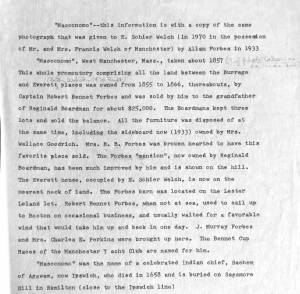
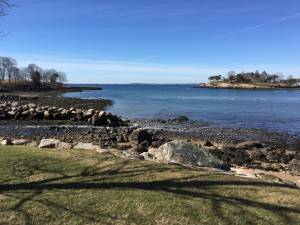
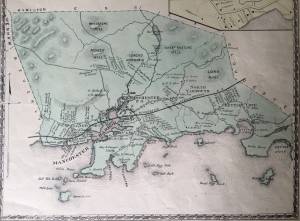
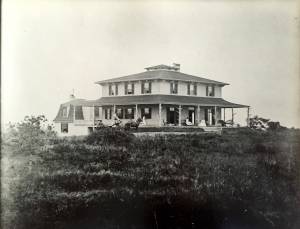
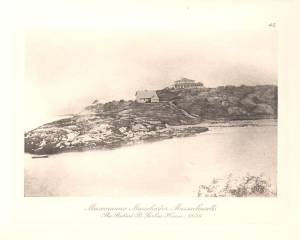
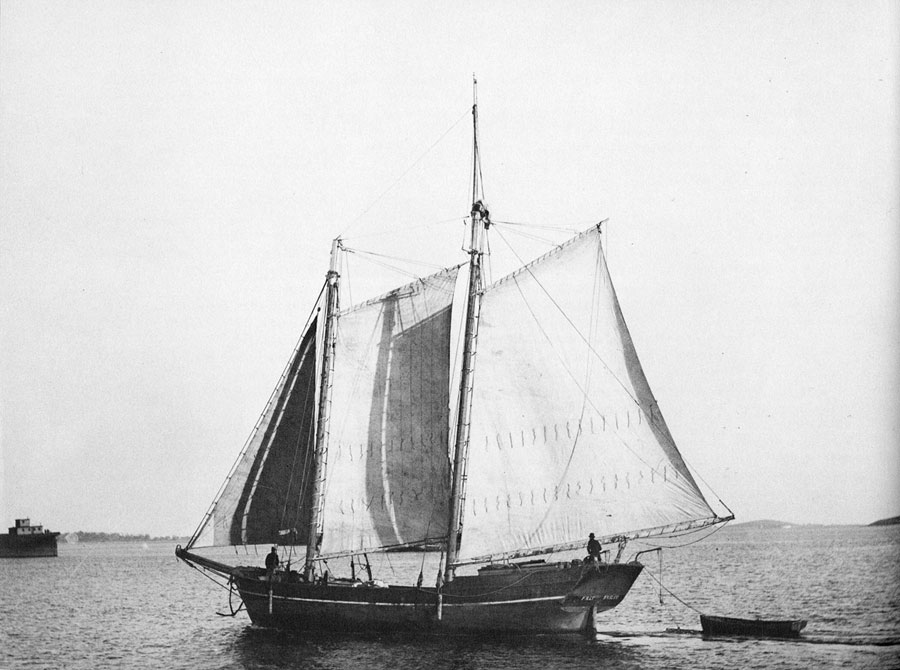
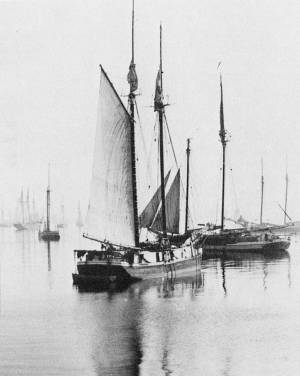


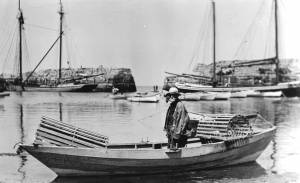

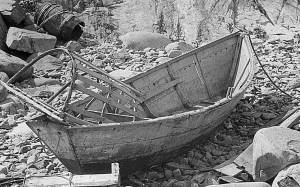


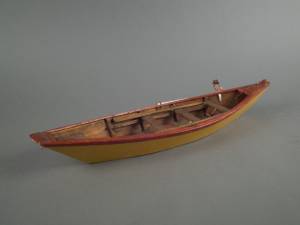



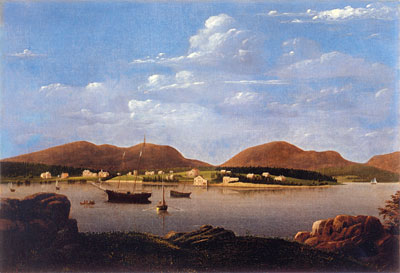


Commentary
Fitz Henry Lane's luminous views of beaches and harbors from Massachusetts to Maine have long been considered some of the finest achievements in nineteenth-century American landscape painting. His works' signature serenity has been identified as an artistic corollary to the roughly contemporary development of Transcendentalist philosophy and Unitarian faith in the Boston area.
In recent years, Lane's relationship with his gifted student and collaborator Mary Blood Mellen has come to light, altering the attributions of numerous works once securely identified as Lane's. In his 2007 study Fitz Henry Lane & Mary Blood Mellen: Old Mysteries and New Discoveries, John Wilmerding reported that Dana Beach, Manchester "appears to be a joint effort, with Lane having executed the strong foreground edge, while Mellen depicted the beach itself and entire background."
– From the Philadelphia Museum of Art's wall label
[+] See More